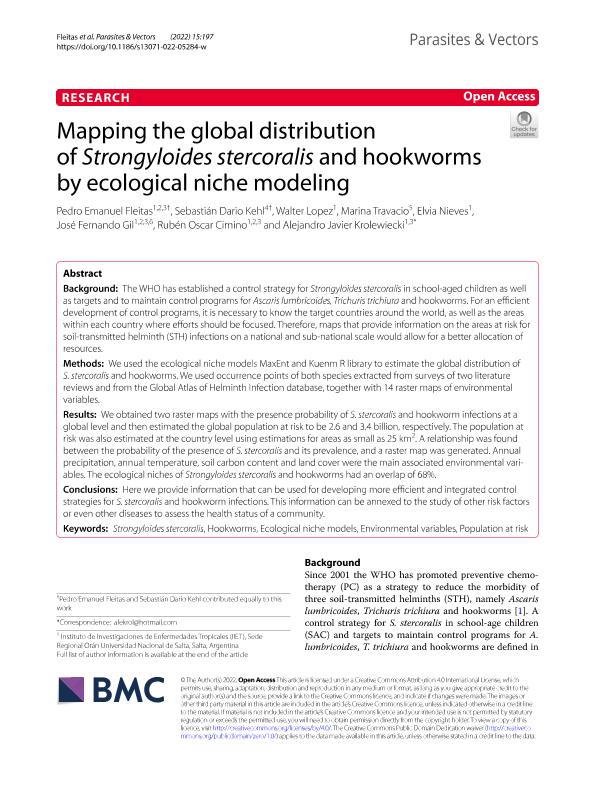Mostrar el registro sencillo del ítem
dc.contributor.author
Fleitas, Pedro Emanuel

dc.contributor.author
Kehl, Sebastian Dario

dc.contributor.author
López, Walter Rodrigo

dc.contributor.author
Travacio, Marina

dc.contributor.author
Nieves, Elvia Ester

dc.contributor.author
Gil, José Fernando

dc.contributor.author
Cimino, Rubén Oscar

dc.contributor.author
Krolewiecki, Alejandro Javier

dc.date.available
2023-11-02T16:51:10Z
dc.date.issued
2022-06
dc.identifier.citation
Fleitas, Pedro Emanuel; Kehl, Sebastian Dario; López, Walter Rodrigo; Travacio, Marina; Nieves, Elvia Ester; et al.; Mapping the global distribution of Strongyloides stercoralis and hookworms by ecological niche modeling; BioMed Central; Parasites and Vectors; 15; 1; 6-2022; 1-12
dc.identifier.issn
1756-3305
dc.identifier.uri
http://hdl.handle.net/11336/216884
dc.description.abstract
Background: The WHO has established a control strategy for Strongyloides stercoralis in school-aged children as well as targets and to maintain control programs for Ascaris lumbricoides, Trichuris trichiura and hookworms. For an efficient development of control programs, it is necessary to know the target countries around the world, as well as the areas within each country where efforts should be focused. Therefore, maps that provide information on the areas at risk for soil-transmitted helminth (STH) infections on a national and sub-national scale would allow for a better allocation of resources. Methods: We used the ecological niche models MaxEnt and Kuenm R library to estimate the global distribution of S. stercoralis and hookworms. We used occurrence points of both species extracted from surveys of two literature reviews and from the Global Atlas of Helminth Infection database, together with 14 raster maps of environmental variables. Results: We obtained two raster maps with the presence probability of S. stercoralis and hookworm infections at a global level and then estimated the global population at risk to be 2.6 and 3.4 billion, respectively. The population at risk was also estimated at the country level using estimations for areas as small as 25 km2. A relationship was found between the probability of the presence of S. stercoralis and its prevalence, and a raster map was generated. Annual precipitation, annual temperature, soil carbon content and land cover were the main associated environmental variables. The ecological niches of Strongyloides stercoralis and hookworms had an overlap of 68%. Conclusions: Here we provide information that can be used for developing more efficient and integrated control strategies for S. stercoralis and hookworm infections. This information can be annexed to the study of other risk factors or even other diseases to assess the health status of a community.
dc.format
application/pdf
dc.language.iso
eng
dc.publisher
BioMed Central

dc.rights
info:eu-repo/semantics/openAccess
dc.rights.uri
https://creativecommons.org/licenses/by/2.5/ar/
dc.subject
ECOLOGICAL NICHE MODELS
dc.subject
ENVIRONMENTAL VARIABLES
dc.subject
HOOKWORMS
dc.subject
POPULATION AT RISK
dc.subject
STRONGYLOIDES STERCORALIS
dc.subject.classification
Parasitología

dc.subject.classification
Ciencias de la Salud

dc.subject.classification
CIENCIAS MÉDICAS Y DE LA SALUD

dc.title
Mapping the global distribution of Strongyloides stercoralis and hookworms by ecological niche modeling
dc.type
info:eu-repo/semantics/article
dc.type
info:ar-repo/semantics/artículo
dc.type
info:eu-repo/semantics/publishedVersion
dc.date.updated
2023-11-01T11:10:42Z
dc.journal.volume
15
dc.journal.number
1
dc.journal.pagination
1-12
dc.journal.pais
Reino Unido

dc.journal.ciudad
Londres
dc.description.fil
Fil: Fleitas, Pedro Emanuel. Universidad Nacional de Salta. Sede Regional Orán. Instituto de Investigación de Enfermedades Tropicales; Argentina. Consejo Nacional de Investigaciones Científicas y Técnicas. Centro Científico Tecnológico Conicet - Salta; Argentina
dc.description.fil
Fil: Kehl, Sebastian Dario. Universidad Nacional de Salta. Sede Regional Orán. Instituto de Investigación de Enfermedades Tropicales; Argentina
dc.description.fil
Fil: López, Walter Rodrigo. Universidad Nacional de Salta. Sede Regional Orán. Instituto de Investigación de Enfermedades Tropicales; Argentina. Consejo Nacional de Investigaciones Científicas y Técnicas. Centro Científico Tecnológico Conicet - Salta; Argentina
dc.description.fil
Fil: Travacio, Marina. Universidad Nacional de Salta. Sede Regional Orán. Instituto de Investigación de Enfermedades Tropicales; Argentina
dc.description.fil
Fil: Nieves, Elvia Ester. Universidad Nacional de Salta. Sede Regional Orán. Instituto de Investigación de Enfermedades Tropicales; Argentina. Consejo Nacional de Investigaciones Científicas y Técnicas. Centro Científico Tecnológico Conicet - Salta; Argentina
dc.description.fil
Fil: Gil, José Fernando. Universidad Nacional de Salta. Sede Regional Orán. Instituto de Investigación de Enfermedades Tropicales; Argentina. Consejo Nacional de Investigaciones Científicas y Técnicas. Centro Científico Tecnológico Conicet - Salta. Instituto de Investigaciones en Energía no Convencional. Universidad Nacional de Salta. Facultad de Ciencias Exactas. Departamento de Física. Instituto de Investigaciones en Energía no Convencional; Argentina
dc.description.fil
Fil: Cimino, Rubén Oscar. Universidad Nacional de Salta. Sede Regional Orán. Instituto de Investigación de Enfermedades Tropicales; Argentina. Consejo Nacional de Investigaciones Científicas y Técnicas. Centro Científico Tecnológico Conicet - Salta; Argentina
dc.description.fil
Fil: Krolewiecki, Alejandro Javier. Universidad Nacional de Salta. Sede Regional Orán. Instituto de Investigación de Enfermedades Tropicales; Argentina. Consejo Nacional de Investigaciones Científicas y Técnicas. Centro Científico Tecnológico Conicet - Salta; Argentina
dc.journal.title
Parasites and Vectors

dc.relation.alternativeid
info:eu-repo/semantics/altIdentifier/url/https://parasitesandvectors.biomedcentral.com/articles/10.1186/s13071-022-05284-w
dc.relation.alternativeid
info:eu-repo/semantics/altIdentifier/doi/http://dx.doi.org/10.1186/s13071-022-05284-w
Archivos asociados
